In Janice Kulyk Keefer’s The Green Library, it is Eva Chown, a forty-three year old middle class woman living in Canada, who tries to find her Ukrainian identity within herself through stories. She has to go back to the stories of her ancestors and to a history of a country she barely knows in order to find out what ‘being half Ukrainian’ means to her and her son, Ben. On her way back ”[…] into a world of stories […]” (Keefer, 1998, 17) she listens to many of them told by strangers, reads history books, and also “makes up” her own stories of what might have happened. In whichever form the stories appear, they change her life and mark her identity. But it is not only Eva whose identity is so often influenced by stories. The Green Library presents many characters who define themselves through stories in one way or another.
This paper will argue that stories are the marker of one’s identity, that they can even help construct it. These stories can be based upon personal experiences or historical events. They can be true for everybody or they can only be true for the person telling them. As Dan P. McAdams, Ruthleen Josselson, and Amia Lieblich put it in their book Identity and Story: Creating Self in Narrative “We are all storytellers, and we are the stories we tell.” (3) Furthermore our “[…] identities are the stories we live by.” (McAdams, Josselson, Lieblich 4)
In the beginning of the paper the concepts of story, history, and identity, which are relevant for the theses, are briefly defined. It will be analysed which impact stories can have on the life of a person and various examples from the Green Library will be discussed. Since ‘Eva’ is the protagonist of the novel the paper will very often be concentrated on her experiences but will also include other character’s stories. After that it will be analysed how identities can be constructed through stories with the example of Oksanna Moroz. In the end there will be a description of the value of history in the book and the differences and similarities between story and history will be deconstructed primarily regarding the aspect of truth. In conclusion the concept of a bloodline as one major marker of identity will be discussed.
Inhaltsverzeichnis (Table of Contents)
- Introduction
- Story
- History
- Identity
- "We are all tellers of tales" (McAdams 11)
- Stories help us to understand other people (McAdams 11)
- Stories about Eva's ancestors
- Stories about Ukraine
- Stories help you to understand yourself
- Stories help us to understand other people (McAdams 11)
- To construct an identity through stories
- History and Truth
- Value of History in the book
- Influence of history on Dan and Alex
- Difference between History and Story - Truth
- Making up stories
- The story about Eva's father
- Ben and his grandpa
- Conclusion
Zielsetzung und Themenschwerpunkte (Objectives and Key Themes)
This paper aims to analyze the role of stories in shaping identity, particularly within the context of Janice Kulyk Keefer's novel "The Green Library." The paper explores how stories, both personal and historical, can contribute to the construction of identity, offering insights into the experiences of characters grappling with their heritage and sense of self.- The significance of stories in understanding oneself and others
- The role of stories in constructing and shaping identity
- The interplay between history, truth, and personal narratives in shaping identity
- The power of stories to connect individuals across generations and cultures
- The impact of stories on personal experiences and perspectives
Zusammenfassung der Kapitel (Chapter Summaries)
This section focuses on summarizing the main themes, arguments, or narrative elements of each chapter, excluding summaries of the conclusion, final chapter, or any sections containing major revelations or spoilers.- Introduction: This chapter introduces the concept of stories as markers of identity, drawing upon the work of McAdams, Josselson, and Lieblich. It defines the key terms "story," "history," and "identity" as they relate to the themes explored in the paper. The chapter highlights how stories, whether personal or historical, can contribute to our understanding of ourselves and others.
- "We are all tellers of tales" (McAdams 11): This chapter emphasizes the importance of storytelling in human interaction. It explores how stories help us understand other people, countries, and cultures, and how they can influence our perspectives and identity. The chapter also delves into how stories connect people through shared experiences and narratives.
- To construct an identity through stories: This chapter examines how stories can be used to construct an identity, particularly for individuals like Eva Chown in "The Green Library" who are seeking to understand their heritage and sense of self. The chapter provides examples from the novel to illustrate how stories can help individuals to define themselves and their place in the world.
- History and Truth: This chapter explores the value of history in shaping identity. It discusses the influence of history on the characters in "The Green Library" and examines the differences and similarities between history and stories, particularly in relation to truth. The chapter also explores the concept of "making up stories" and how they can contribute to a personal sense of identity.
Schlüsselwörter (Keywords)
This paper focuses on the intricate relationship between storytelling and identity, utilizing key concepts like personal narratives, historical events, and the interplay of truth and imagination. The study delves into the experiences of individuals in "The Green Library" who grapple with their cultural heritage and personal histories, demonstrating how stories contribute to a deeper understanding of self and the world around them.- Quote paper
- Anika Kehl (Author), 2010, Stories as the marker of one’s identity in Janice Kulyk Keefer’s "The Green Library", Munich, GRIN Verlag, https://www.grin.com/document/279052



